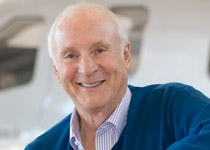Proficient Pilot: Riding shotgun
Scrooges, tyrants, and a good skipper
A co-pilot flies with, observes, and learns from a wide variety of captains. He can adopt the techniques he finds most useful and ignore the others, an opportunity not afforded general aviation pilots—who graduate from student pilot to “captain” with the stroke of an examiner’s pen. The co-pilot must be a chameleon and adapt to each captain with whom he serves and, while most captains are agreeable, there are some who make the job unpleasant.
One of my classmates at TWA, Dusty Spain, tells of when he was a new Connie co-pilot flying with a captain who had a reputation for harassing co-pilots. While at cruise altitude, this captain barked at Dusty, “Open your side window.” This was the first pressurized airplane Dusty had ever flown, and he was reluctant to comply. The captain, now shouting, said, “I told you to open your window!” Dusty pulled on the handle and was relieved to discover that the window would not budge. He could not overcome the pressurization. The tyrant in the left seat said, “When a captain tells you to do something, you do it immediately.”
Back when TWA operated Martin 404s, a large twin-engine, piston-powered airplane, there was a captain who allowed his co-pilots to fly every other leg but never let them make the landing. Upon reaching cruise altitude, he would tilt his seat back, go to sleep, and wake up in time to take over and make the approach and landing, frustrating and irritating his co-pilots.
The tyrant in the left seat said, “When a captain tells you to do something, you do it immediately.”On one flight, the co-pilot—who shall remain nameless—had had enough of Captain Scrooge. He made every effort to descend and approach the destination airport as smoothly as possible so as not to awaken the captain. He flipped off the captain’s audio switch, reduced power ever so gradually, and slid the airplane into the overcast obscuring Kansas City. He then silenced the marker beacon receiver and got to within a mile of touchdown, something no other co-pilot flying for this captain had ever achieved. The captain, however, woke up; grabbed the controls as the runway lights began to appear in the nighttime mist; and landed the airplane…at the wrong airport.
It was not that long ago that airlines used three-man crews. A major advantage of being a member of such a crew is that if you were to inadvertently flatulate, no one could know with certainty that you were the guilty party. Not so in the case of a two-man crew. The co-pilot’s job was also easier in those days because the flight engineer did the grunt work. When my son, Brian, was a co-pilot on a three-man crew—he’s now a captain for American Airlines—he would describe his simplified duties by saying, “Pitot heat, window heat, what’s to eat?”
Co-pilots these days are trained to be more assertive. Instead of merely “hinting and hoping” when they see a captain doing something questionable, they are taught to be both direct and respectful.
My good friend, Al Desrosiers, for example, was co-pilot on a Boeing 707 flight into Honolulu at night. The aircraft was south of Oahu and cleared from 8,000 feet to 2,000 feet msl. Being too high, the captain pulled off the power and shoved the nose down. Passing through 3,000 feet, Al gave the requisite warning, “Out of three for two.” But the captain showed no sign of leveling off. He then busted his altitude and continued diving for sea level, his mind obviously elsewhere. Al yelled out, “Skipper, we’re only 10 seconds from swimming, and I don’t know how!” He grabbed the control wheel and hauled back, flexing the wings as the dive was arrested.
My favorite TWA captain was Frank Timoshik. My first flight with him was on a Boeing 707 cargo flight, a red-eye to New York. While we were in dispatch he told me, “You fly it to Kennedy, and I’ll fly it home. I don’t care how you fly the airplane as long as it’s safe, legal, and comfortable—in that order,” a mantra that I applied when I became a captain. It is advice that I also apply to my general aviation flying.
The goal of serving time as a co-pilot is to become a captain. According to a retired Air New Zealand captain, Brian Souter, “Being a captain is no different than being a co-pilot except that when you look to the left for assistance and ideas, you see only your own reflection in the window.”



